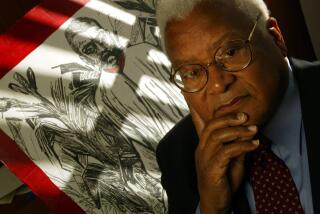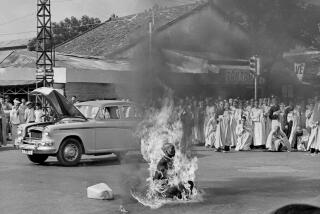Hate and Redemption: The Life of Wallace
On June 11, 1963, with the temperature a sticky 95 degrees, he made his famous stand in the doorway against two African American students seeking to register at the University of Alabama, defiantly drawing his line in the sand against equal rights and common decency in the name of âsegregation now, segregation tomorrow, segregation forever.â
Thirty-five years later, he ended life a shrunken, haunting, almost pathetic figure seeking absolution after publicly renouncing the hatred and wickedness heâd nourished for political advantage in a racial war zone of church bombings and murders.
For the record:
12:00 a.m. April 22, 2000 For the Record
Los Angeles Times Saturday April 22, 2000 Home Edition Calendar Part F Page 2 Entertainment Desk 1 inches; 27 words Type of Material: Correction
Wallace gunman--The man who shot George Wallace while he was campaigning for president in 1972 was Arthur Bremer. He was misidentified in an article Friday about a PBS documentary about Wallace.
If George Corley Wallace isnât the most fascinating story in modern U.S. politics, heâll do until another slick-haired, soft-drawling, do-anything-to-get-elected-until-seeing-the-light-and- asking-forgiveness demagogue comes along.
What a âturbulent, tragic path he blazed,â host-historian David McCullough observes at the outset of âGeorge Wallace: Settinâ the Woods on Fire,â another fine, layered biography from the aptly titled PBS series âThe American Experience.â
And how instructive to hear the redemption now being granted Wallace in some circles. âMaybe you can say the cause was wrong, but I think the man in many ways was right,â says aspiring president Pat Buchanan early in this two-part documentary from producers Paul Stekler and Dan McCabe and writer Steve Fayer.
Note Buchananâs fence-straddling âmaybe.â
As if there were any doubt about the evil racist core of the segregation cause emblazoned by Wallace through the 1960s and into the 1970s. Or any doubt about the suffering it caused as he rode the race issue all the way to the Alabama governorâs mansion and national prominence on behalf of an Old Dixie that deceptively festooned itself in red, white and blue.
Just as some South Carolinians continue to argue disingenuously today that the Confederate flag fly
ing atop their statehouse is not a symbol of racism.
In effect, âSettinâ the Woods on Fireâ is equally about the Americans who embraced Wallaceâs message in Alabama, and also the millions elsewhere after he set his sights north on the White House and articulated his national mantra of Populist politics with an eye toward exploiting an anti-Washington backlash. Much of it was code for his old message, for Wallace was an acute observer and tactician who understood that racism was not confined to the South.
Narrator Randy Quaidâs flat folksiness is overmatched here by the material, and a weird Muzak drones monotonally in the background. Otherwise, âSettinâ the Woods on Fireâ rises to the challenge of its subject.
That includes Wallaceâs relationship with his first wife, Lurleen, who was elected governor as his surrogate when the state constitution stopped him from seeking reelection in 1966. She died of cancer in the middle of her term, and prominent here is a tender memory of her last moments of life, with Wallace whispering, âGoodbye, sweetheart,â as she lay dying in the governorâs mansion.
Especially riveting, too, is an account of Wallace being stalked by Charles Brimmer, featuring eerie video of the would-be assassin applauding on the campaign trail as Wallace pursued the Democratic nomination for president in 1972. Then comes the rapid fire at a political rally in Laurel, Md.
âAll of a sudden I heard dot, dot, dot-dot-dot, and then time stood still,â recalls Wallaceâs second wife, Cornelia.
One of five Brimmer bullets that struck Wallace penetrated his spinal cord, sending him permanently to a wheelchair and altering the course of his life irrevocably. And perhaps also sensitizing him to the anguish heâd imposed on others.
Like TNTâs admirable 1997 film âGeorge Wallace,â this documentary digs for the âreal Wallaceâ deep beneath the bombastic rhetoric of a political ruffian who swings his fists on the stump as he once did in the ring as an amateur boxer. Heâs someone who fulfills his vow never to be âoutniggeredâ again after losing a 1958 gubernatorial run to a race-baiting segregationist when Wallace was still a moderate-to-progressive circuit court judge.
Not that Wallaceâs true feelings about race would matter to the peaceful civil rights demonstrators--he called them âlittle pinkosâ--who faced cattle prods, police dogs and fire hoses in the segregated Alabama he led for much of his career. Or to the families of the four little girls who died in a 1963 explosion at Birminghamâs 16th Street Baptist Church.
As J.K. Chestnut, an African American attorney from Selma, says here: âForgive? Yes. Forget? Never.â
Yet this examination of Wallaceâs complex character--told largely through interviews with his family, political intimates and other close-up observers--is an intriguing journey into the soul of a shrewd pragmatist who, in the surreal final act of his political life, was maintained in power by the very African Americans whom he had victimized for years.
Somehow they could turn the other cheek.
This stunning act of forgiveness âsprang from the core faith of an oppressed people,â Dan T. Carter writes in âThe Politics of Rage: George Wallace, the Origins of the New Conservatism, and the Transformation of American Politics,â on which this documentary is partially based.
And for many others, Carter adds, âThere is the promise: If George Wallace could wipe clean the slate of his past and reach across the divide of race, his is a story with an uplifting ending which offers hope for us all.â
Itâs quite a concept to ponder, this merging Wallace with some sort of amazing grace as he confronts his moral crimes in an act of contrition. You think of that while watching a remarkable close-up of him in old age, puffing on a big cigar and dominating the screen as he once dominated newscasts and newspapers.
Only now, with his life near an end, his eyes are no longer defiant, but are downcast beneath bushy gray brows. Seeing what, you wonder.
* Part 1 of âThe American Experienceâ âGeorge Wallace: Settinâ the Woods on Fireâ can be seen Sunday at 9 p.m. on KCET-TV and KVCR-TV; it concludes Monday.
Howard Rosenbergâs column appears Mondays, Wednesdays and Fridays. He can be contacted via e-mail at [email protected].
More to Read
The complete guide to home viewing
Get Screen Gab for everything about the TV shows and streaming movies everyoneâs talking about.
You may occasionally receive promotional content from the Los Angeles Times.






